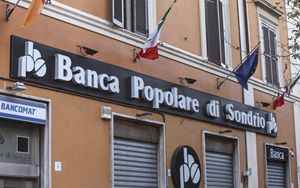(Finance) – The Board of Directors of Banca Popolare di Sondriowhich met yesterday, approved the “Next Step” Industrial Plan 2022-2025, which defines the Bank’s strategy and new targets. The first floor della Popolare as SpA sees a significant and sustainable generation of value, solid capitalization, less sensitivity to inflationary pressures and targeted digital investments.
“It is a matter of pride for me to be able to present our first Industrial Plan after transforming ourselves into a SpA at the end of 2021. With the foundation in Sondrio in 1871, we were one of the first cooperative banks in the country”, remembers the CEO Mario Alberto Pedranziniadding “our vocation is to grow. To grow together with our customers, with our employees, beyond the confines of a traditional Banca del Territorio. With rigor, availability towards customers, proximity to the communities of the areas served, while preserving our identity but continuing to innovate “.
“In the last ten years, characterized by the well-known difficulties of the context, our operating margin has largely covered and exceeded credit losses, unlike the sector average. Our capitalization is at the top of the system. We are the Italian bank that has grown the most. organically, investing in people and the Internet “.
A bank that acts as a bank
The Next Step Industrial Plan 2022-2025 – underlines Pedranzini – tells the prospects of one “bank that acts as a bank”focused on its distinctive areas, intending to grow in areas, such as savings management and the bancassurancein which we believe we still have ample potential, evolving in meaning digital the relationship with ours clientele. This bank is committed to distributing in the coming years more than half a billion in dividendswith an annual payout of 50%. “The bank will distribute over 550 million coupons over the next 4 years.
The numbers of the Plan
Looking at the targets of the Plan, one is foreseen net profit growth to 323 million euros by 2025 and an increase in ROE at 9.2%. Core profitability is expected to increase to 1.1 billion in 2025, with an interest margin of 667 million by 2025 (2021-2025 CAGR equal to + 6%) and estimated net commissions at 443 million (2021-2025 CAGR equal to a + 5.5%)
New push on managed savings and bancassurance. In fact, the four-year plan estimates net loans to customers to grow to 35.9 billion in 2025 and volumes of assets under management and insurance equal to 13.8 billion, with a 2021-2025 CAGR of + 12%. Insurance premiums are seen to grow in the four-year period with 2021-2025 CAGR equal to + 11%
High capital strength and robust liquidity position with a CET 1 ratio at 15.6% at the end of 2025 and above 15% in each year of the Plan, a Liquidity Coverage Ratio above 140% in each year of the Plan and a Net Stable Funding Ratio above 125%. It also continues the derisking activity with gross NPL ratio expected to decrease to 3.8% by 2025 and cost of risk at 47 bps by 2025.
Investments in technology and digital are expected
The Bank’s technological development will be supported by important investments. In particular, investments are planned in personnel and digitalization, with cost base under control. There IT spending is expected to grow to 120 million in 2025 (from 86 million in 2021); operating costs of 619 million in 2025 (from 558 million in 2021) with a Cost / Income ratio seen to decline to 51.8% in 2025 (from 54.1% in 2021).
The initiatives of this director aim to further evolve the traditional branch model, towards a multi-channel physical / digital interaction (phygital), also thanks to the robotization and automation of processes to improve the experience
customers and free commercial energy.
More attention to ESG issues
Particular emphasis is given to the iintegration of ESG factors into the business and in operation; in fact, the Bank bases all its activities on harmonious management of the relationship with the reference territories, the starting point for the development of a solid sustainability strategy consistent with its values.
A strengthening of the commitment to sustainability and inclusion is envisaged, through a series of initiatives: definition of ESG performance targets; integration of sustainability into the Bank’s main processes, through a policy adjustment and internal regulations, in particular in the areas of credit, investments and risk management; development of new sustainable products and services; responsible investment guidelines; issue of new ESG Bonds; adhesions to ESG initiatives more relevant to the banking sector; interventions to further strengthen governance; continuous performance monitoring emissive and energy; definition of a broader ESG communication strategy.
